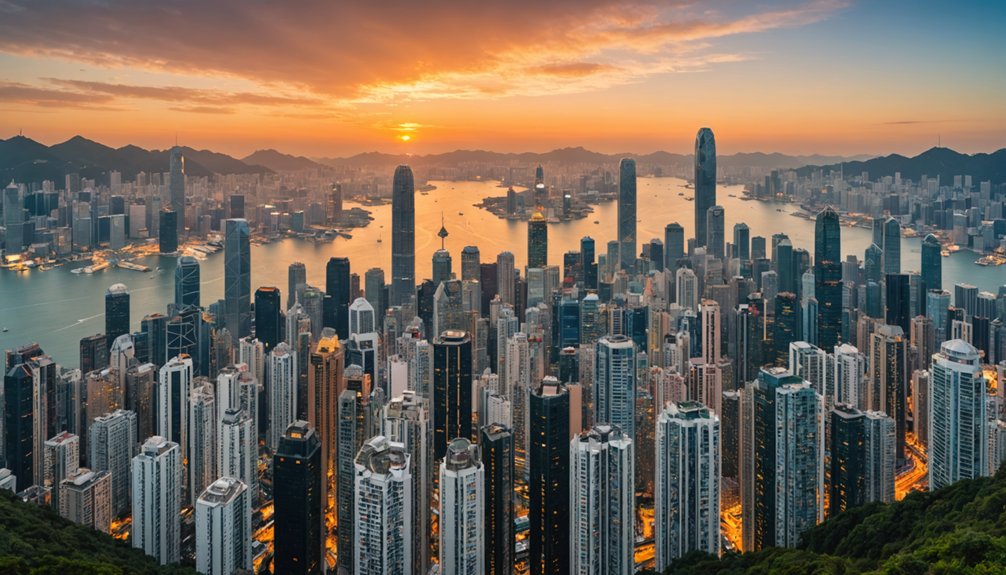The best time to visit Hong Kong is during autumn (October-November) when you’ll enjoy delightful temperatures between 23-27°C, low humidity, and bright skies. You’ll avoid both summer’s intense heat and winter’s peak tourist crowds, while saving 40-60% on accommodations compared to holiday periods. This comfortable season is perfect for exploring outdoor attractions, hiking trails, and scenic spots. The city’s rich cultural experiences and natural beauty truly shine during these golden months.
Explore East Asia
Find the perfect time to visit these travel hotspots
Key Takeaways
- October to December offers ideal temperatures (19-27°C), low humidity, and clear skies perfect for outdoor activities and sightseeing.
- Avoid July-August when intense heat, humidity, and frequent rainfall can make exploring uncomfortable and disrupt travel plans.
- March-May brings beautiful spring blossoms and moderate crowds, though prepare for occasional rain showers.
- Skip December-February peak season to avoid inflated accommodation prices and overwhelming tourist crowds during holidays.
- Late September to early November has fewer typhoon risks and comfortable autumn weather for hiking and outdoor adventures.
Weather Patterns Throughout the Year
While Hong Kong’s subtropical climate creates distinct seasonal changes throughout the year, you’ll find each period offers unique characteristics worth considering for your visit. Winter brings refreshing temperatures between 13°C-18°C, with monthly rainfall dropping below 50mm and cool northerly winds sweeping through the city. Spring’s unpredictable weather shifts from clear skies to sudden downpours, while summer ushers in intense heat and humidity, with temperatures soaring above 31°C.
You’ll experience dramatic monthly rainfall trends, peaking at nearly 400mm during the summer months when typhoons are most likely. Autumn emerges as the golden season, offering delightful temperatures around 23°C-27°C and steadily decreasing precipitation. Low humidity and bright skies make autumn the best season to visit Hong Kong. Seasonal wind patterns play an essential role, from winter’s chilly northerly monsoons to summer’s moisture-laden breezes. By November, you’ll enjoy stable weather with abundant sunshine, making it ideal for exploring the city’s outdoor attractions.
Peak Tourist Seasons and Crowd Levels
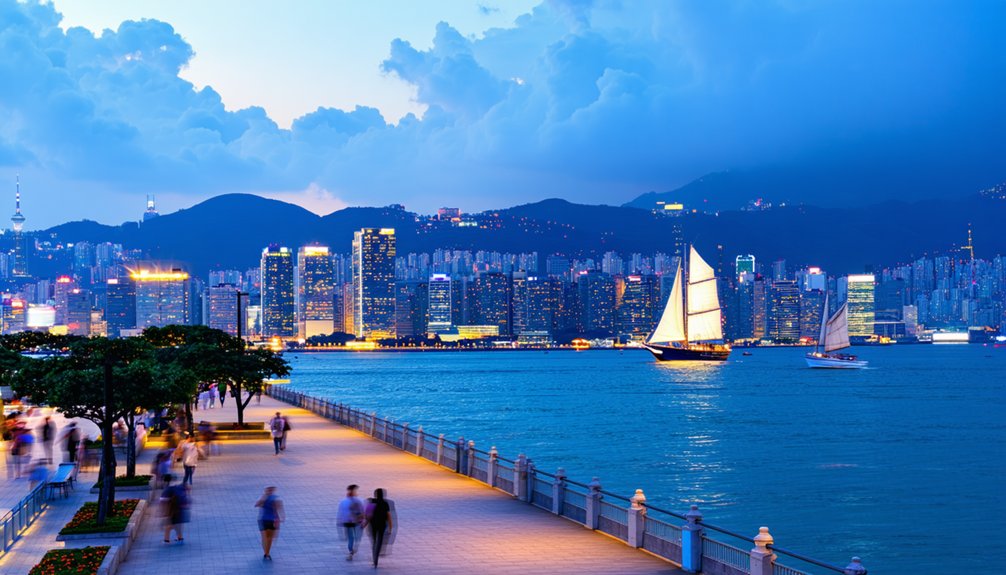
When planning your Hong Kong trip, you’ll need to navigate the city’s distinct tourist patterns that shape crowd levels throughout the year. The city experiences its heaviest influx during three main periods: summer (July-August) with 8.38M visitors, winter holidays (December-February), and Chinese New Year.
You’ll find accommodation availability tightest and seasonal pricing surges most dramatic during these peaks, with hotel rates jumping 40-60% around Christmas and Chinese New Year. August claims the highest visitor count at 4.45M, while December attracts 4.2M+ tourists seeking holiday festivities and shopping deals. The weather remains mild and pleasant during peak seasons, though attractions and public transportation can become overwhelmingly crowded.
For a more relaxed experience, consider visiting during shoulder seasons. March, June, and September see the lowest tourist numbers, averaging around 3.2M visitors monthly. If you’re flexibility-minded, these months offer better deals on hotels and shorter queues at major attractions, especially during early morning or evening hours.
Autumn’s Perfect Outdoor Adventures
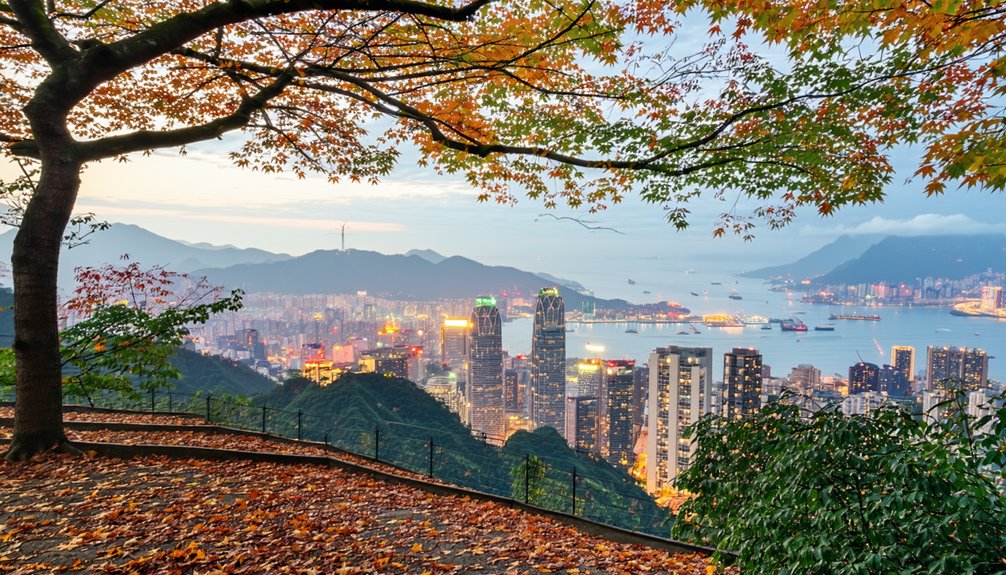
As autumn’s gentle breezes sweep through Hong Kong, you’ll discover the year’s most spectacular season for outdoor exploration. With temperatures hovering between 19°C to 28°C and minimal rainfall, you can freely explore the city’s diverse hiking trails and scenic spots without summer’s stifling humidity. The cooler weather and relatively less humidity make it an ideal time for extended outdoor activities.
Trek the Dragon’s Back Trail for stunning coastal views, or head to Butterfly Hill where you’ll encounter vibrant autumn foliage and prime wildlife spotting opportunities. The Shing Mun Reservoir trail offers a perfect blend of history and nature, featuring WWII relics and peaceful paperbark tree groves. For photographers, Lau Shui Heung Reservoir’s mirror-like surface perfectly reflects the seasonal colors.
Make your adventures even more memorable during the Mid-Autumn Festival, when you can combine hiking with cultural experiences. Watch the Tai Hang Fire Dragon Dance, then head to Victoria Peak for unmatched nighttime views of the illuminated harbor below.
Winter Festival Highlights and Cultural Events
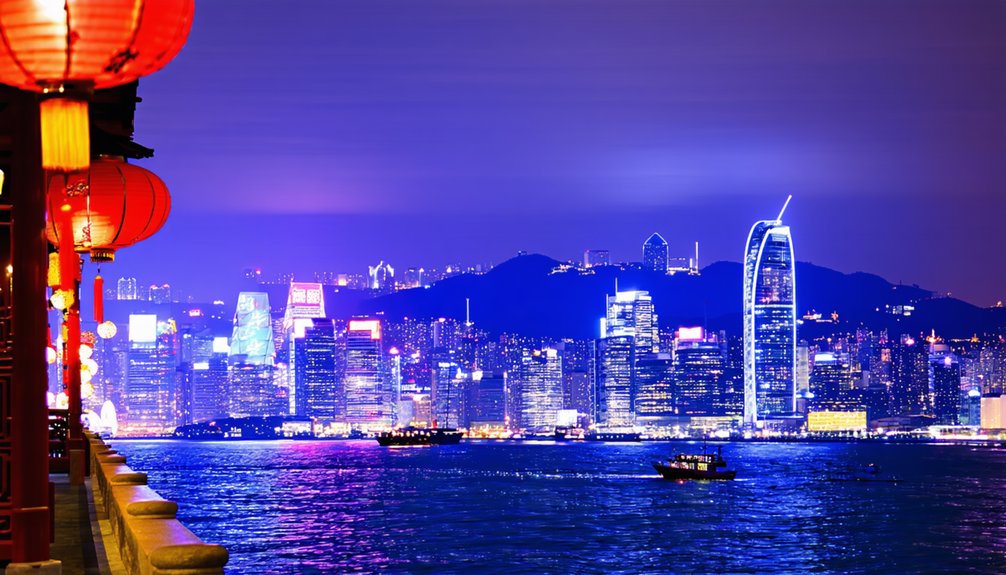
Hong Kong’s winter festivities transform the city into a dazzling wonderland from late November through early January. You’ll experience the magic of WinterFest at West Kowloon Cultural District, where a towering 20-meter Christmas tree illuminates the night sky alongside spectacular Victoria Harbour pyrotechnics.
Don’t miss the unique cultural traditions that blend Eastern and Western celebrations. While exploring Christmas Town’s gnome-themed installations and choir performances, you can also embrace local customs like Winter Solstice family gatherings and temple visits. The festive seasonal dining scene offers everything from Michelin-recommended clay pot rice to international treats at the WestK Christmas Market. Visitors can walk through a mesmerizing festive light tunnel that creates stunning photo opportunities.
For the ultimate year-end celebration, position yourself along the Tsim Sha Tsui waterfront, where nine landmark buildings light up the harbor as synchronized fireworks welcome the New Year. Theme parks and cultural venues across the city also feature special winter programming, ensuring endless entertainment options.
Spring Blossoms and Natural Attractions
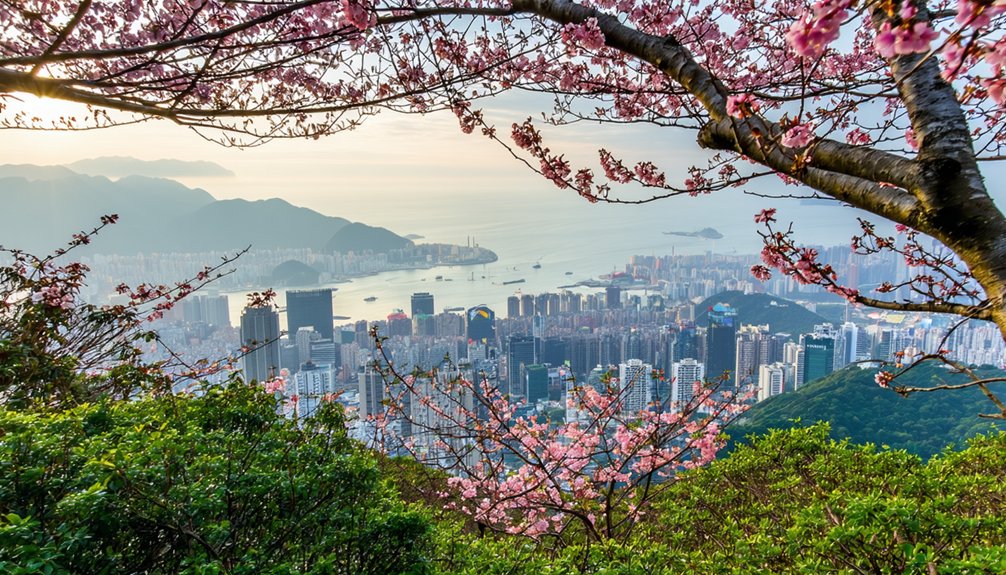
If you’re seeking Hong Kong’s most enchanting spring displays, you’ll find spectacular cherry blossoms at Hong Kong Velodrome Park and Cheung Chau Kwan Kung Pavilion from late February through March. The city transforms into a photographer’s paradise with golden trumpet trees creating stunning yellow canopies at Nam Cheong Park, while rhododendron tunnels at Un Chau Estate offer dreamy pink and white flora displays. Visitors can easily reach these flower-viewing spots via Exit D1 at Nam Cheong Station for convenient access to the beautiful blooms. For the best viewing experience, check the LCSD’s Flower Appreciation website for real-time bloom updates and plan your visits on weekdays to avoid the crowds.
Cherry Blossom Viewing Spots
When spring arrives in Asia’s world city, you’ll find spectacular cherry blossoms blooming across several prime viewing locations. From February to April, you can explore diverse cherry tree varieties at spots like Rotary Park, where 38 Taiwan-origin trees line nature trails, or Tai Po Waterfront Park, home to elegant Yoshino and Fuji cherries near a spiral lookout tower. Nature enthusiasts can also visit Kwan Kung Pavilion on Cheung Chau island for a peaceful hanami experience.
For the best viewing experience, check blooming forecasts on the LCSD website before your visit. Don’t miss the 85 subtropical-adapted sakura trees at Cherry Blossom Garden near the airport, or the illuminated evening displays at Quarry Bay Promenade. The Hong Kong Velodrome Park offers a unique blend of Japanese and Taiwanese species, perfect for combining your cherry blossom viewing with outdoor activities.
Park Wildflower Trails
Nature enthusiasts and flower photographers will find paradise along Hong Kong’s diverse wildflower trails during spring. You’ll discover the best blooms from March to April when temperatures hover between 19-26°C, perfect for exploring paths like Dragon’s Back Trail and Tai Mo Shan’s MacLehose Trail Section 8.
For rare flower species, head to Pat Sin Leng Nature Trail where wild roses and Hong Kong pavetta thrive in protected conservation areas. Visit Kadoorie Farm and Botanic Garden for guided walks featuring native orchids, or explore Sai Kung East Country Park for stunning hibiscus displays. Lantau Island offers diverse coastal blooms throughout spring and summer. To maximize your experience, start hiking early (6-9 AM) and always check weather conditions through HK Observatory. Remember to stay on marked paths – you’ll help preserve these delicate ecosystems while capturing unforgettable wildflower moments.
Summer Activities and Indoor Escapes
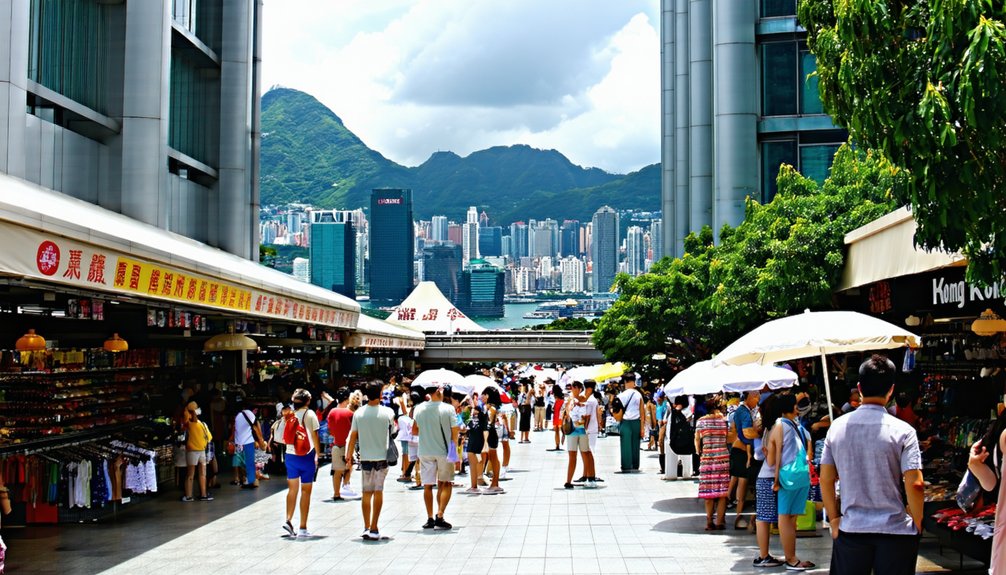
Hong Kong’s sweltering summers don’t have to slow you down, thanks to an impressive mix of outdoor adventures and air-conditioned havens. Whether you’re seeking affordable staycation packages or family friendly indoor playgrounds, the city offers countless ways to beat the heat while having fun.
Cool off with these crowd-pleasing options:
- Immerse yourself in public pools like Kennedy Town’s harbor-view facility or Kowloon Park’s waterfall-adorned oasis for just HK$20
- Escape to LEGOLAND Discovery Centre’s creative workshops, or challenge yourself at Impact Force CQB’s augmented reality games
- Charter a junk boat to secluded South China Sea bays for swimming and adventure
For cultural enthusiasts, Tai Kwun heritage center provides a perfect blend of history and contemporary art, while Water World Ocean Park’s 27 attractions spread across 14 acres offer high-energy thrills. Stay connected throughout your adventures with unlimited data plans starting from just $4.99 per day. When evening falls, explore MICHELIN-starred restaurants near historical sites or join seasonal festivities like the Dragon Boat races.
Transportation and Travel Considerations
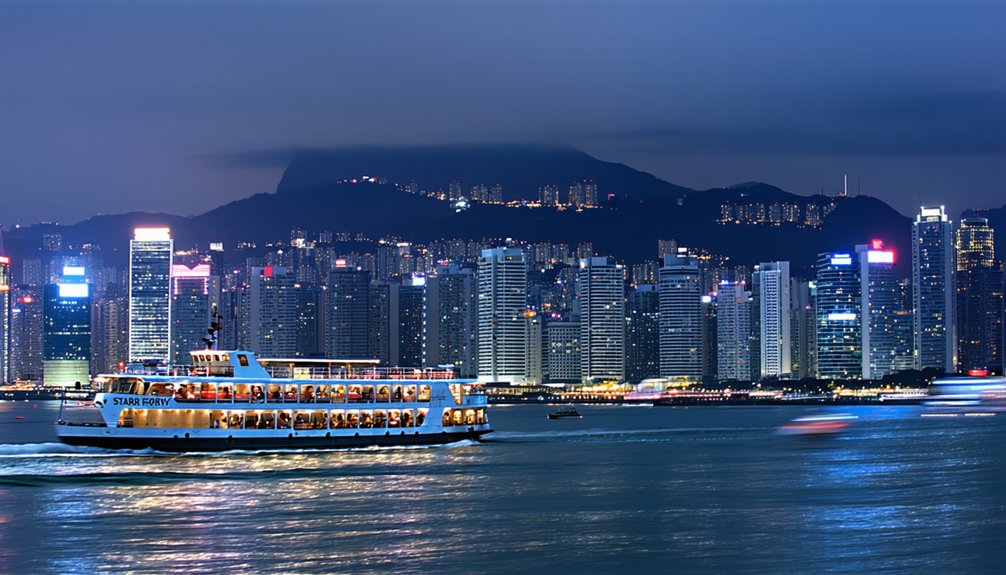
You’ll find Hong Kong’s extensive public transport system less crowded during off-peak hours (10 AM-4 PM), making it easier to navigate with luggage and avoid the morning rush of commuters. Rainy season (April-September) can impact ferry services and create longer taxi wait times, so it’s smart to plan buffer time into your schedule and keep your Octopus card loaded. While the MTR runs reliably in most weather conditions, typhoon warnings can disrupt outdoor transport options like trams and ferries, particularly during summer months. The HKeMobility mobile app helps travelers plan optimal routes and check real-time traffic conditions during any weather-related disruptions.
Peak vs. Off-Peak Travel
While visiting Hong Kong is exciting year-round, timing your trip strategically can dramatically impact your experience and budget. You’ll find stark differences between peak and off-peak periods that affect everything from wait times to costs.
For the best experience and maximum savings, consider these key timing strategies:
- Choose mid-week visits (Tuesday-Thursday) to enjoy 40% fewer crowds at major attractions
- Opt for early morning (7:00-9:30 AM) or late-night (after 9:00 PM) travel to reduce wait times by 70%
- Plan your visit during October-November for ideal weather and balanced crowd levels
Taking the Peak Tram ride is particularly enjoyable during off-peak hours, as you’ll have a better chance of securing the best viewing seats and experiencing the famous tilting skyscraper illusion without crowds blocking your view.
Weather Impact on Transport
Beyond timing your visit around crowds, understanding how weather affects Hong Kong’s transportation system can make or break your travel plans. The city’s transport network shows impressive resilience during disruptions, but you’ll want to plan around typhoon season (May-September) when possible.
| Weather Condition | Transport Impact |
|---|---|
| Typhoon Signal 8+ | Most buses and ferries suspend |
| Post-Storm | Recovery within 1-2 hours |
| Winter/Autumn | Minimal disruptions |
For the most reliable transportation experience, target late September through December. You’ll avoid both the peak typhoon months and summer’s humidity-related delays. If you must travel during storm season, the MTR offers the most dependable service, often running even under Signal 8 conditions, though it’ll suspend operations at Signal 9 or above. During post-typhoon recovery periods, expect ferry journey times to be longer than usual due to unstable sea conditions.
Budget-Friendly Travel Periods
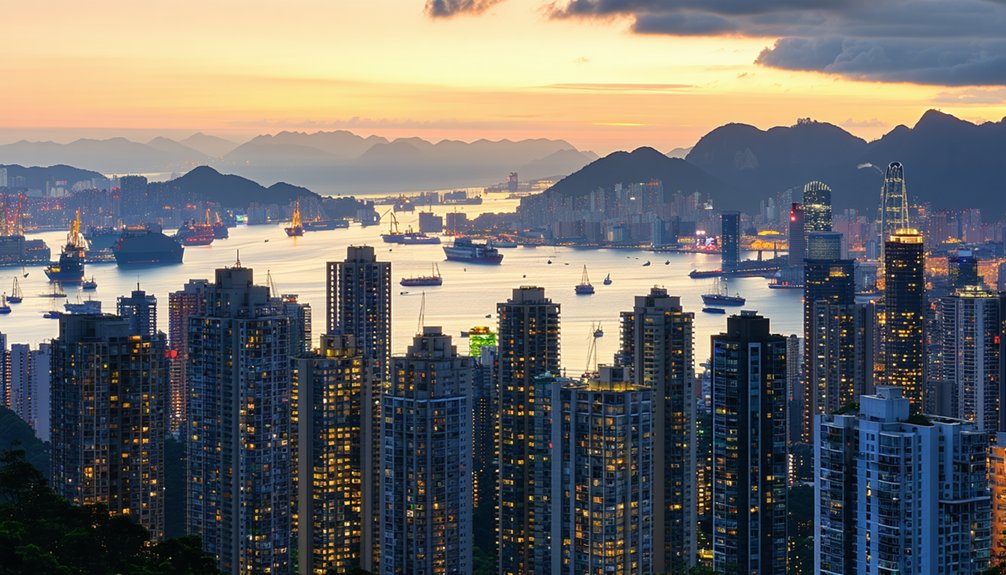
Planning a budget-friendly trip to Hong Kong requires strategic timing of your visit. Summer months offer the most significant savings, with discounted hotel rates up to 50% lower than peak season. While you’ll face high humidity and heat, you’ll acquire substantial savings on both flights and accommodations during July and August. Tourism experts recommend a stay of 5 days minimum to properly experience Hong Kong’s main attractions.
For maximum value, consider these money-saving travel periods:
- May-June: Catch cheaper flights and budget accommodation options, but prepare for potential typhoons
- February (after Chinese New Year): Score winter deals without peak season crowds
- March-April: Enjoy moderate prices and pleasant weather with occasional rain
Book your accommodations 3-4 months ahead, especially in budget-friendly areas like Kowloon and North Point. Avoid October-November when trade shows drive up prices, and December-January’s peak rates unless you’re specifically aiming for festival experiences. Mid-week flights typically offer additional savings of 10-15% compared to weekend departures.
Must-Visit Attractions by Season
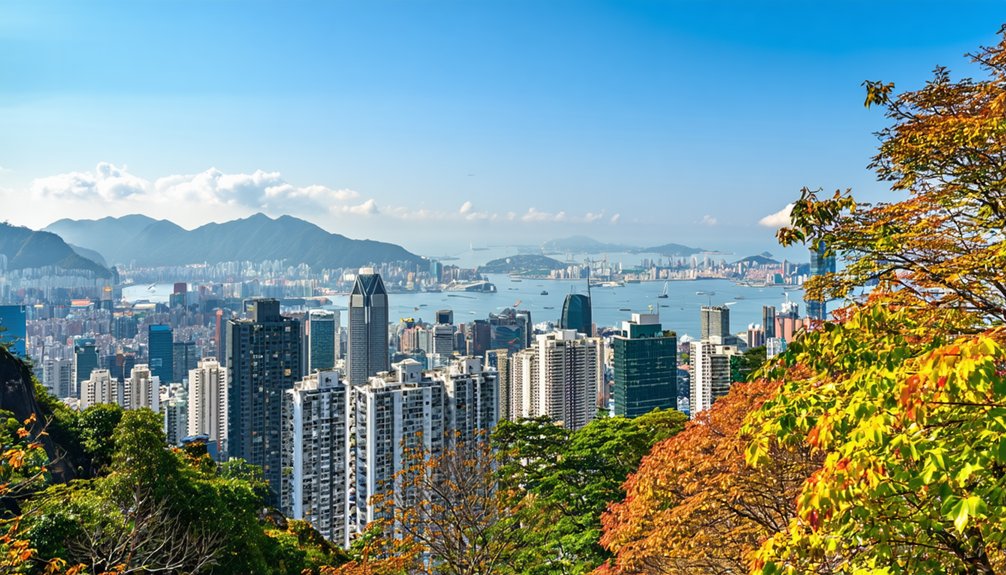
Depending on when you visit Hong Kong, you’ll discover unique seasonal attractions that showcase the city’s vibrant culture and natural beauty. In winter, immerse yourself in Chinese New Year festivities, complete with food tours through Temple Street Night Market and spectacular firework displays. Spring brings artistic flair with the Hong Kong Arts Festival and Flower Show, while coastal hikes along Dragon’s Back Trail offer stunning vistas.
Summer heats up with the energetic Dragon Boat Festival races and beachfront activities at Repulse Bay. Join cultural festivals like Summerfest for live entertainment and local flavors. The season experiences high humidity levels from June through August, so indoor attractions provide welcome relief. As autumn arrives, don’t miss the enchanting Mid-Autumn Festival lantern displays and the prestigious Wine and Dine Festival at Central Harbourfront.
Year-round, you can’t go wrong with iconic experiences like the Symphony of Lights show at Victoria Harbour or a spiritual journey to Tian Tan Buddha via the scenic Ngong Ping cable car.
Weather Safety and Emergency Preparations
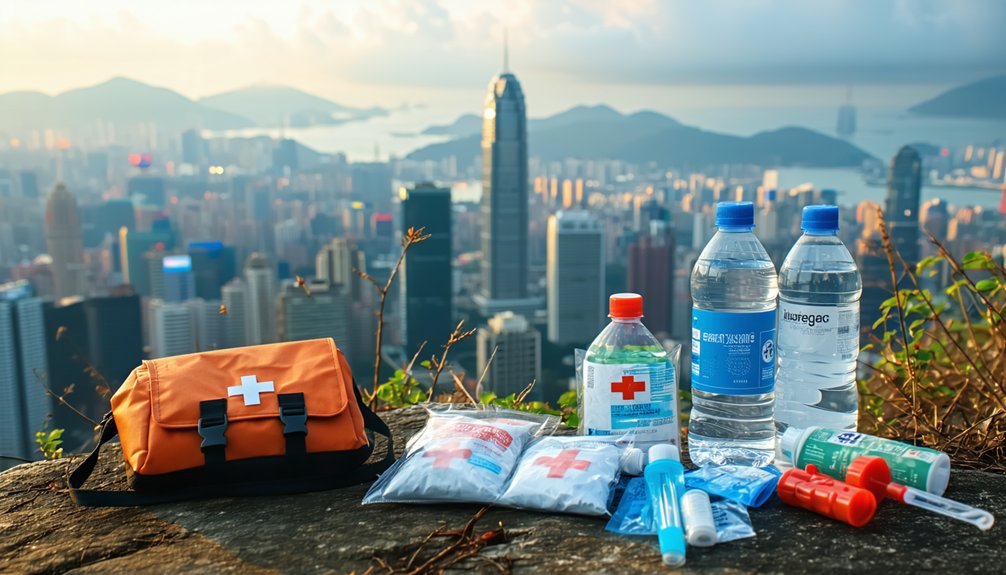
During typhoon season (May-November), you’ll need to monitor Hong Kong’s warning signal system, where a Signal No. 8 means immediate closure of businesses and public transportation. Keep emergency supplies ready, including flashlights, batteries, non-perishable food, water, and a battery-powered radio to stay updated on real-time alerts. You can access official warnings through TV, radio, and social media channels, while dialing 999 connects you to emergency services if needed. Since 80% of annual rainfall occurs between May and September, it’s essential to pack waterproof gear and sturdy umbrellas during these months.
Typhoon Warning Protocol
When severe weather threatens Hong Kong, you’ll need to understand the city’s detailed typhoon warning system. The city uses a numbered signal system ranging from 1 to 10, with each level triggering specific safety protocols and closures.
During severe storms, you’ll want to follow these critical steps:
- Monitor the Hong Kong Observatory’s real-time updates through their website or app
- Know your nearest emergency shelters and evacuation procedures when Signal 8 or higher is raised
- Stay informed about transport suspensions, as MTR underground services may continue while above-ground lines halt
When Signal 8 approaches, most businesses close and employers must release staff. If you’re caught in a Signal 9 or 10, stay indoors away from windows and follow official guidance for your safety. This warning system has evolved significantly since its inception in 1884, when red drums and cones were used to alert residents of approaching storms.
Essential Emergency Supplies
Anyone visiting Hong Kong should maintain a well-stocked emergency kit to handle the city’s unpredictable weather patterns and potential natural disasters. You’ll want to pack essential items like a 3-day supply of drinking water, non-perishable food, and emergency lighting with spare batteries. Don’t forget your mobile devices and chargers for staying connected.
For weather emergencies, include plastic covers and basic repair tools like hammers and nails. Your hygiene supplies and sanitation kits should contain toothbrushes, soap, disposable masks, and hand sanitizer. Pack shelter essentials like emergency blankets and waterproof sheeting, especially during typhoon season. Consider adding water purification tablets to your emergency supplies for safe drinking water during disasters. Finally, maintain a basic first aid kit with bandages, antiseptics, and any prescription medications you require. Having these supplies ready will help you stay safe and self-reliant during unexpected situations.

